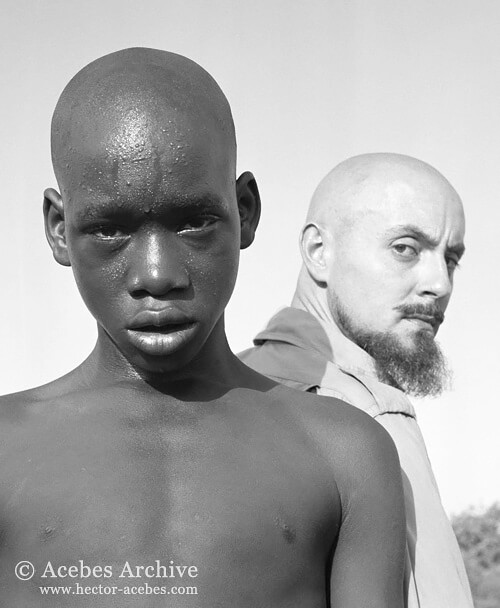Hector Acebes was an American photographer, notable for his expeditions to Africa and South America. He was born in 1921 in New York City, and spent most of his childhood in Madrid (Spain) and Bogotá (Colombia). He went on his first long-distance voyage at the age of thirteen, going 400 miles from Bogota to the city of Barranquilla when he ran from home to
"sail around the world". He was trained at the New York Military Academy and would serve in the US army in World War II on the European front. He studied engineering at the Massachusetts Institute of Technology (MIT), and graduated in 1947.
He married Madeline Acebes in Boston, and they would have a son and two daughters. His first major photographic expedition was to North Africa in 1947. He embarked on a second trip to West Africa, specifically Timbuktu in 1949. Between 1950 and 1953, he embarked on several expeditions to the Orinoco River in Venezuela, and to other parts of South America. He went on his final, most extensive African expedition in 1953, going throughout the continent, from Dakar to Zanzibar. After this, he began a career as an industrial filmmaker for engineering projects throughout South America. In his final years Acebes lived in Bogota, and worked on creating the Hector Acebes Archive. He died in Bogota on 22 April 2017.
Acebes's African photographs are often viewed as a departure from colonial anthropologists such as
Casimir Zagourski, in whose footsteps he followed. He himself rejected the label of "anthropologist", seeking to distance himself from its colonial connotations. The work of many previous photographers was often in service to the European colonization of Africa, and sought to document Africans as colonial subjects, Acebes's portraits gave the subjects more agency to pose, express emotions and individuality, thus departing from this tradition to an extent. Hector Acebes thus existed in a transitional area between colonial anthropologists, and concurrently emerging native African photographers such as
Seydou Keïta, in terms of the agency and depiction of Africans within his work.
Source: Wikipedia
Hector Acebes was born in New York City in 1921. He was raised in Madrid, Spain, and attended the Colegio del Pilar. His family moved to Bogotá, Colombia, where he attended the Gimnasio Moderno. Acebes returned to the United States for high school at the New York Military Academy. He gained much of his technical photographic skill by participating in the school’s camera club and through study and practice on his own.
After graduating from the Chauncey Hall School in Boston, he entered Massachusetts Institute of Technology to study engineering. While in college, he maintained his own photo studio. During World War II, he enlisted in the U.S. Army and served in Germany. On his return, he completed his degree at MIT and then moved with his wife to Bogotá. He has a son and two daughters.
Throughout the late 1940s and the 1950s, Acebes took expeditions through Africa and South America and started his work as a professional filmmaker and lecturer. By the late 1950s, Acebes Productions had established a reputation for creating excellent documentary and industrial films. Acebes wrote, filmed, directed, and edited each of the forty-three films Acebes Productions released.
Hector Acebes died at the age of 96 on April 22, 2017 in Bogotá.
For the last ten years, the Hector Acebes Archives has been active in bringing Acebes' work to the attention of galleries, collectors, and museums. It is managed by Ed Marquand.
Source: Hector Acebes Archives
